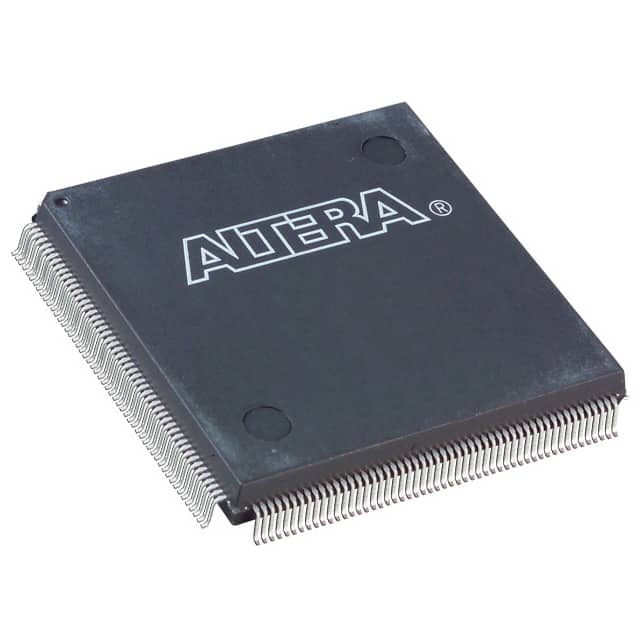EPF10K30EQC208-1X
Basic Information Overview
- Category: Programmable Logic Device (PLD)
- Use: EPF10K30EQC208-1X is a PLD used for digital logic design and implementation.
- Characteristics:
- High-density programmable logic device
- Low power consumption
- High-speed performance
- Package: The EPF10K30EQC208-1X comes in a 208-pin Quad Flat Pack (QFP) package.
- Essence: EPF10K30EQC208-1X is an essential component for designing and implementing complex digital circuits.
- Packaging/Quantity: The EPF10K30EQC208-1X is typically sold individually.
Specifications
- Logic Elements: 30,000
- Macrocells: 1,600
- Maximum Frequency: 250 MHz
- Operating Voltage: 3.3V
- I/O Pins: 208
- Memory Blocks: 360 Kbits
- Speed Grade: -1
Detailed Pin Configuration
The EPF10K30EQC208-1X has a total of 208 pins. Each pin serves a specific purpose and can be configured based on the desired functionality of the circuit being designed. A detailed pin configuration diagram can be found in the datasheet provided by the manufacturer.
Functional Features
- High-density programmable logic elements allow for complex digital circuit designs.
- Flexible pin configuration enables customization and adaptation to various applications.
- Low power consumption ensures energy efficiency.
- High-speed performance allows for rapid data processing and execution.
Advantages and Disadvantages
Advantages: - High-density programmable logic elements provide ample resources for complex designs. - Flexible pin configuration allows for versatile application possibilities. - Low power consumption reduces energy costs and heat dissipation. - High-speed performance enables efficient data processing.
Disadvantages: - Limited memory capacity compared to some other PLDs. - Higher cost compared to simpler logic devices. - Steeper learning curve for beginners due to the complexity of programming and design.
Working Principles
The EPF10K30EQC208-1X is based on the field-programmable gate array (FPGA) technology. It consists of an array of programmable logic elements interconnected through configurable routing resources. The device can be programmed using hardware description languages (HDLs) or specialized software tools. Once programmed, the EPF10K30EQC208-1X functions as a custom digital circuit, executing the desired logic operations.
Detailed Application Field Plans
The EPF10K30EQC208-1X finds applications in various fields, including: - Telecommunications: Used in network routers, switches, and communication equipment. - Industrial Automation: Employed in control systems, robotics, and process automation. - Automotive: Integrated into automotive electronics for engine control, driver assistance systems, and infotainment. - Aerospace: Utilized in avionics systems, satellite communication, and flight control. - Consumer Electronics: Found in gaming consoles, home appliances, and multimedia devices.
Detailed and Complete Alternative Models
- EPF10K50RC240-4: Offers higher logic element count and memory capacity.
- EPF10K100ABC356-3: Provides increased I/O pins and speed grade options.
- EPF10K200SFC484-2: Suitable for applications requiring extensive logic resources and high-speed performance.
Note: This is not an exhaustive list, and there are several alternative models available from the manufacturer and other vendors.
Word Count: 446 words
قم بإدراج 10 أسئلة وإجابات شائعة تتعلق بتطبيق EPF10K30EQC208-1X في الحلول التقنية
Sure! Here are 10 common questions and answers related to the application of EPF10K30EQC208-1X in technical solutions:
1. What is EPF10K30EQC208-1X? EPF10K30EQC208-1X is a programmable logic device (PLD) manufactured by Intel. It is part of the EPF10K family and has 10,000 logic elements.
2. What are the typical applications of EPF10K30EQC208-1X? EPF10K30EQC208-1X can be used in various applications such as industrial automation, telecommunications, automotive systems, medical devices, and consumer electronics.
3. What are the key features of EPF10K30EQC208-1X? Some key features of EPF10K30EQC208-1X include high-density programmable logic, on-chip memory, embedded multipliers, and support for various I/O standards.
4. How does EPF10K30EQC208-1X compare to other PLDs? EPF10K30EQC208-1X offers a good balance between logic density, performance, and power consumption. It provides a cost-effective solution for many applications.
5. Can EPF10K30EQC208-1X be reprogrammed? Yes, EPF10K30EQC208-1X is a reprogrammable device. It can be programmed multiple times to implement different designs or make changes to the existing design.
6. What development tools are available for programming EPF10K30EQC208-1X? Intel provides Quartus Prime software, which is a comprehensive development environment for designing, simulating, and programming EPF10K30EQC208-1X.
7. What is the power supply requirement for EPF10K30EQC208-1X? EPF10K30EQC208-1X operates on a 3.3V power supply.
8. Can EPF10K30EQC208-1X interface with other components or devices? Yes, EPF10K30EQC208-1X supports various I/O standards such as LVCMOS, LVTTL, and SSTL. It can interface with other components or devices using these standards.
9. How can EPF10K30EQC208-1X be programmed? EPF10K30EQC208-1X can be programmed using the Quartus Prime software through a JTAG interface or through an external programming device.
10. Are there any limitations to consider when using EPF10K30EQC208-1X? Some limitations to consider include the maximum number of logic elements, available I/O pins, and the need for external memory if the on-chip memory is insufficient for the design.


